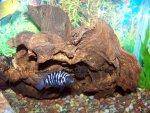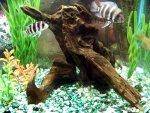Complete Guide to Aquarium Driftwood: Tips, Selection, Preparation, and Maintenance
Quick links - Answers
Brief Description & Links
Welcome to our comprehensive guide on using driftwood and aquarium wood. This page covers everything from selecting and cleaning driftwood to its effects on water chemistry, how to attach plants, and much more. For those seeking to purchase driftwood, click here to find a list of online suppliers. Share your experiences or ask questions about driftwood using the form at the bottom of the page. We look forward to hearing from you!
Introduction
Adding driftwood to your aquarium can significantly enhance the aesthetic appeal and create a natural environment for your fish. Driftwood and aquarium wood, much like aquatic plants, serve multiple purposes, including creating hiding places, reducing stress, and even affecting water chemistry.
There are many types of driftwood and wood available for aquarium use, and each has its own unique properties. This guide will cover how to choose the right type of wood, prepare it for use, and ensure it's safe for your fish.
Types of Driftwood and Aquarium Wood
There are various types of aquarium wood, each with different characteristics, benefits, and visual appeal. Here’s a detailed look at some of the most popular types of aquarium wood, as well as a few lesser-known options:
- Mopani Wood: A dense, hard wood found in Africa, Mopani wood is highly sought after for its durability and unique appearance. It has two-toned color patterns, with one side often dark brown and the other light beige, creating an aesthetically pleasing contrast. Its gnarled, intricate shapes make it a popular choice for aquascaping. While it releases tannins that can darken the water, many aquarists appreciate this for its ability to lower pH and mimic natural blackwater environments.
- Malaysian Driftwood: Originating from Southeast Asia, this wood is extremely dense, making it ideal for sinking immediately without much preparation. Its dark, twisted branches create a natural, rugged look in aquariums. Malaysian Driftwood releases tannins more slowly than other types, making it easier to control water discoloration. Due to its widespread availability and variety of shapes, it’s a top choice for aquarists looking to create complex hiding spots for fish and shrimp.
- Bog Wood: Found in bogs and wetlands, this type of wood is naturally soaked and preserved over time. Bog wood has a rustic appearance, often split or cracked, which adds texture to an aquarium. It’s rich in tannins, which helps lower pH, making it great for South American biotopes. Bog wood can be heavy and durable but may need extra soaking to prevent leaching excess tannins into the water.
- Spider Wood (Azalea Root): Known for its spider-like, twisted branches, this type of wood is becoming increasingly popular in aquascaping. Its lightweight, intricate structure makes it perfect for smaller aquariums or nano tanks. Spider wood often needs to be soaked or weighed down at first to prevent floating, but its striking appearance makes it worth the effort. It also serves as a perfect anchor for plants like Java Moss and Anubias.
- Cholla Wood: Cholla wood comes from the dried skeleton of a cholla cactus, native to the southwestern U.S. and Mexico. It has a distinctively hollow, porous structure with large holes running along its length, making it an excellent option for shrimp tanks. The porous surface allows for easy attachment of plants and promotes the growth of biofilm, which is essential for shrimp and fry. It decays slowly and releases minimal tannins, so it won’t dramatically alter water chemistry.
- Manzanita Wood: A highly durable and lightweight wood from the western U.S., Manzanita is becoming a popular option for aquariums. It has thin, winding branches that create an elegant, minimalist look in aquascapes. Because it’s so lightweight, it often needs to be soaked for extended periods or anchored with rocks to keep it submerged. Manzanita is prized for its longevity and minimal impact on water chemistry.
- Poly-resin Driftwood: This synthetic alternative is made from molded resin to resemble real wood. It’s designed for aquariums where water chemistry needs to remain stable, as it doesn’t alter the water’s pH or release tannins. Poly-resin driftwood is available in various shapes and sizes, some even featuring attached artificial plants, making it ideal for aquarists seeking aesthetic value without the need for extra preparation or maintenance.
Is Driftwood Safe?
Driftwood is generally safe for aquariums, provided it doesn't contain harmful substances such as heavy metals or pesticides. It's recommended to purchase driftwood from reputable aquatic stores. If you're collecting driftwood from nature, take precautions. Wood found near polluted areas may absorb harmful chemicals, while marine driftwood can contain salt that might harm freshwater fish. Boiling and soaking can help make found driftwood safer.
How Does Driftwood Affect pH Levels?
One of the key benefits of driftwood is its ability to lower pH levels. It slowly releases tannins, which can give the water a yellow or brown tint, but this is perfectly natural and often creates a more authentic environment for species like Discus and Angelfish, which prefer slightly acidic water. The extent to which driftwood lowers pH depends on the size of the wood, the type of water in your aquarium, and the amount of time it has been soaking.
How to Clean Driftwood for Your Aquarium
Cleaning driftwood is essential before adding it to your tank. You can boil it to sterilize and remove tannins, or soak it for a few weeks, changing the water regularly. This helps remove any debris and reduces the yellowing of your aquarium water. You can also scrub the driftwood with a brush to remove algae, though many aquarists prefer to let algae grow naturally for a more authentic look.
How to Keep Driftwood Submerged
Some types of driftwood will float when first added to an aquarium. To prevent this, you can soak the wood in water for several days or weeks. If it still floats, attach it to a rock or piece of slate using aquarium-safe silicone. Eventually, the wood will absorb enough water to sink on its own.
Preparing and Selecting Driftwood for Your Tank
When selecting wood for your aquarium, opt for dense, hard woods, as soft woods decay quickly and create debris. Choose pieces that suit the size of your tank and allow ample space for fish to swim and hide. Unique shapes can add character and offer more hiding places for your fish. Soaking new wood helps remove debris and tannins, but removing tannins is optional since they are not harmful to fish. Some aquarists prefer the natural color they add to the water, while others choose to soak the wood longer to reduce discoloration. Boiling found wood is recommended to sterilize it and remove any salt or other harmful substances.
Pros and Cons of Using Driftwood
Using driftwood has both benefits and drawbacks. Here's a quick look at the pros and cons:
Pros:
- Helps lower pH, making it ideal for fish that prefer acidic water.
- Provides hiding spots and territories for fish, reducing stress.
- Creates a natural and aesthetically pleasing environment.
- Serves as a substrate for algae, which is beneficial for fish like catfish.
Cons:
- Lowers pH, which may be undesirable for fish that prefer alkaline water (e.g., African cichlids).
- May discolor the water, though this is generally harmless.
- Can collect debris or fish waste underneath, requiring regular cleaning.
- Floating driftwood may require additional preparation to sink.
How to Attach Plants to Driftwood
Plants like Java Moss and Anubias are commonly attached to driftwood for aesthetic purposes and to provide cover for fish. Use thread or aquarium-safe glue to attach the plants initially. Over time, the roots will naturally grow into the wood, securing the plants in place.
What Happens If I Boil Aquarium Driftwood?
Boiling driftwood helps sterilize it and remove tannins, which can color the water. The process also makes the driftwood denser, reducing its buoyancy. While boiling is an effective method for making driftwood safer for your tank, it won’t eliminate all bacteria. Some heat-resistant bacteria, such as Bacillus and Clostridium species, can survive extreme temperatures, including boiling. These bacteria form spores that protect them from high heat, although they are generally not harmful to fish. Boil the wood for at least an hour to get the best results and significantly reduce the presence of unwanted pathogens.
What Are the Benefits of Driftwood in an Aquarium?
Aside from its decorative appeal, driftwood has multiple benefits for your aquarium. It provides hiding places for fish, serves as a spawning area, and contributes to a more natural tank environment. Driftwood can also lower pH and soften water, making it more suitable for species that prefer acidic conditions.
Where to Buy Aquarium Driftwood Online
There are many suppliers offering a wide range of aquarium driftwood. Some options include:






